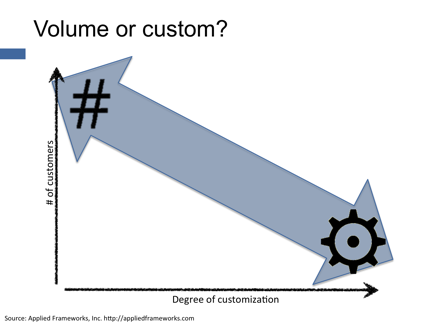The role of product management in sales demos

I’ve seen many product demonstrations. Some good. Some not. In some cases, it’s clear that the person doing the demo hasn’t prepared and is just following a canned script. In others, you can tell that they put a lot of time into tailoring the demo specifically for the client, but even then, the demo can often miss the target.
How do you create a great demo? Show buyers what they need to know. But not necessarily what they think they need to know.
What is the role of product management?
Rule #1: Product management is focused on the overall market while sales teams focus on individual customers.
Many product managers find themselves cast in a role of “demo boy” or demo girl” (or as one team put it, “demo monkey”—that’s gotta feel good!) So they do a lot of demos for individual clients.
During his first week on the job, a product manager got a call from a sales guy who wanted to the product manager to travel to a customer for a demo. The new product manager said, “I don’t do demos yet.” But the sales guy didn’t hear “yet”—he just thought the product manager was refusing to do the demo. He never called the product manager for a demo again. [I dunno—this might be the ideal scenario!]
The correct role for product managers is to create a great demo script and empower sales teams to do their own demos.
Customization
Rule #2: The closer you get to the customer, the more you must customize your information.
There are two approaches to customer demos: canned or custom. Canned demos follow a standard script and can easily be put on video or in a screen capture with voice-over.

While marketing and product management teams focus on large numbers of customers, your sales professionals are focused on customers one at a time. Therefore the customer expects the onsite demo to contain specific illustrations of your capabilities in their environment. They expect to get something from the sales team that they cannot get any other way: specific insights for their implementation.
Canned demos are great for websites but they’re not appropriate for sales teams. There are many examples of good product demos on websites. For example, I found this one for Telerik TeamPulse. It does a good job of explaining a specific capability using a generic scenario. It would move buyers forward one or more steps. But eventually, at least in B2B sales, the customer is going to want to see their specific scenarios.
Customer demos should follow a script (prepared by product management or marketing) to ensure that the key areas of the product are addressed but the script will need to be customized by the sales team to address the specific needs of a single customer. The product manager should note logical branch-points for deviation from the script. For example, “if appropriate, show how to set up a new record (see page xx.”)
The demo center
Rule #3: Demos should be delivered by people who love to give demos.
There’s another problem with product managers doing demos: they often don’t like to do them. Product managers already have a bunch of things to do—answer questions for developers in real time, read aloud to the sales team from sharepoint, email stuff to customers for the support team, rewrite the technical copy for marcom—and they often find demos an annoyance. And customers can tell.
One company had a product demo that absolutely sold the client every time. However the demo setup was quite technical and it couldn’t easily be duplicated in the field. So the product management team got frequent requests from sales people to bring customers into the corporate site for the all-day product demo. The product management leader realized that a) this was a critical step of the sales cycle and b) it wasn’t the responsibility of individual product managers. So he made it a marketing program.
He hired a junior person (a recent graduate from university) to be the full-time person responsible for product demos. They created a dedicated demo center with fancy furniture and comfortable chairs, lots of large displays, and a comprehensive database already set up and ready to go. At a moments notice, they could put on a customer demo that wow’ed them every time. (They also created a script that ran each night to reset the demo configuration back to standard so the next customer wouldn’t see any of the customization that was done for the last customer.)
For technical products that cannot easily be demo’d in the field, this type of demo suite may be the ideal answer.
The closer you get to the customer, the more you must customize your information. White papers, ebooks, blogs, articles, and marketing tools are often too generic for sales teams. These pieces should be used by the customer to move them forward in their buying journey. Sales tools—particularly demos—should be highly customized to show how your product addresses a specific buyer’s needs.

